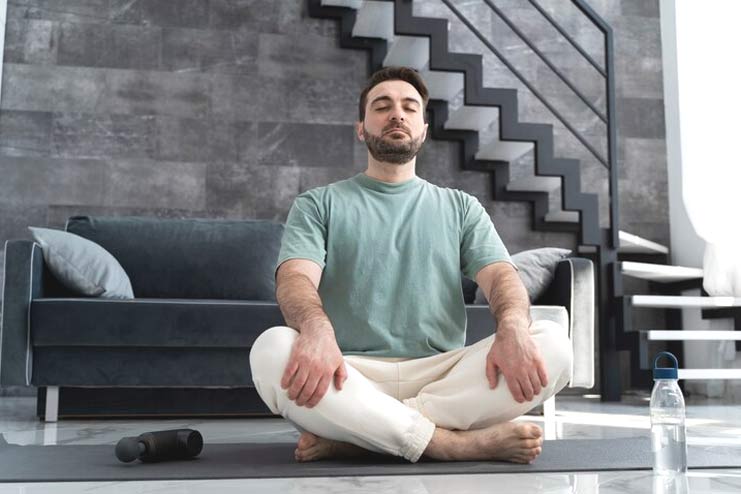Affiliate Disclaimer
Some links in this article are affiliate links. We may earn a small commission if you make a purchase through these links, at no extra cost to you. We only recommend products we find useful to our readersStress is prevalent in men’s lives in our fast-paced society. Understanding how common it is is the first step in developing a shared awareness of stress’s effects on mental health. By acknowledging the everyday experience of stress, we can open a positive and insightful dialogue with men in all spheres of life.
This article explores helpful advice men can use to manage and reduce stress. Join us on a journey to improved well-being and resilience as we examine practical tactics for overcoming the obstacles of contemporary life.
Tip 1: Prioritize Physical Activity

Regular physical activity is a potent remedy for the stressors of contemporary life. Exercise is essential for stress reduction and improves physical health.
Exercise releases endorphins, the body’s natural mood enhancers, elevating mood and fostering calmness. Improving mental clarity and lowering tension, including exercise in everyday routines, can considerably reduce stress.
Think about smoothly integrating physical activity into your everyday routine to make it more accessible. Some easy but powerful ideas include:
- Using the stairs instead of the elevator
- Going for quick walks during breaks
- Incorporating at-home workouts into your bedtime or morning routines
These minor changes significantly impact your life by encouraging a steady release of tension throughout the day. Investigate various exercise modalities and add variation to your routine to make workouts more sustainable in the long term.
Finding an activity that fits your interests and lifestyle, whether team sports, cycling, yoga, or jogging, increases the likelihood of long-term commitment. Even small amounts of daily activity are a significant source of stress alleviation.

Making physical activity a priority is an investment in your health and a proactive approach to stress management. People who understand the value of physical activity and integrate it into their daily routines might develop resilience and strengthen their defenses against the adverse effects of stress.
Tip 2: Embrace Mindfulness and Relaxation Techniques

Adopting mindfulness and relaxation practices is a revolutionary and approachable strategy for stress management. The advantages of adopting these routines go beyond the brief relief they bring, significantly influencing long-term well-being.
Present-moment awareness, the hallmark of mindfulness, encourages emotional equilibrium, mental clarity, and increased self-awareness.
Unlocking the body’s innate relaxation response requires relaxation techniques like deep breathing exercises or meditation. Deliberate, deep breaths that offset the physiological consequences of stress can induce a sense of calm. Whether self-directed or guided, meditation promotes a mental shift toward tranquility and cultivates a sense of peace despite the stresses of daily life.
It is possible to skillfully fit brief periods of mindfulness throughout the day into hectic schedules. Taking a few minutes to perform a quick body scan, pay attention to your breathing, or observe your surroundings without passing judgment can create spots of calm in an otherwise busy day. These easy methods act as anchors, bringing people back to the present and providing a break from the stresses of everyday life.
People who practice mindfulness and relaxation provide themselves with essential tools for managing stress. Including these rituals in everyday life builds resilience and offers a haven of peace in the face of life’s inevitable difficulties. To promote a long-lasting sense of well-being, the path to stress reduction becomes more than merely a destination—instead, it becomes an intentional investigation of the present.
Tip 3: Foster Healthy Connections

Building good relationships becomes a crucial thread in the complex tapestry of stress management, tying emotional well-being into the fabric of our existence. Since humans are social animals, the strength of our relationships with others significantly impacts our capacity to handle stress. Solid social bonds influence a strong sense of support, emotional stability, and perseverance in adversity.
Acknowledging the importance of social ties, friendships, families, and romantic relationships must be fostered. Frequent communication, whether via in-person meetings, phone conversations, or online forums, fortifies the ties that constitute our social support systems. Sharing ideas, feelings, and experiences allows one to express oneself and reduces the emotional toll that stress can take.
Whether it’s a simple lunch, a stroll, or a shared interest, spending time with loved ones strengthens the bonds and creates a sense of camaraderie. These connections are further strengthened by actively listening to others and demonstrating empathy, which lays the groundwork for understanding and trust.
Establishing boundaries and prioritizing self-care is also critical in relationships. Being transparent about your needs and expectations ensures a healthy balance between personal space and connection.
People who intentionally cultivate positive relationships improve their emotional health and build a strong support network to withstand stressful situations. Embracing genuine relationships becomes a source of joy, resilience, and strength in the complex dance of life.
Tip 4: Establish Work-Life Balance

Work-life balance is more important than ever in a world where work often invades personal life. Work-related stress affects mental health, relationships, and life satisfaction.
Practical, balanced lifestyle solutions are needed to manage work-related stress. Set aside time for work, recreation, family, and self-care. Separating work and home can reinforce these boundaries and mark the shift from professional to personal roles.
Prioritizing and distributing duties prevents overwork. Time-management methods, such as the Pomodoro method, promote efficiency without sacrificing well-being by encouraging focused work intervals followed by quick breaks.
Open communication with bosses and coworkers about realistic expectations and probable challenges can also help create a supportive workplace. A culture prioritizing work-life balance boosts workplace satisfaction and productivity.
A healthy work-life balance protects against work-related stress and leads to a more rewarding and sustainable life. Finding this balance is an investment in personal well-being and a key to long-term success and enjoyment.
Tip 5: Prioritize Sleep and Recovery

The importance of sleep on well-being is often underestimated in stress management. The complex relationship between sleep and stress reduction emphasizes the need to rest for mental and physical health. Science shows that sleep regulates stress hormones, improves cognition, and boosts emotional resilience.
Consider practical ways to improve sleep quality and create a relaxing nighttime routine. Set a sleep routine for seven to nine hours per night. Regularity synchronizes the body’s internal clock, enhancing the sleep-wake cycle.
Relaxing pre-sleep routines remind the body to start unwinding. It could include reading, moderate stretches, or mindfulness. Avoiding electronic gadgets before bedtime and providing a pleasant sleep environment with dim lighting and a cool room temperature aids restful sleep.
Nutrition also affects sleep quality. Limiting caffeine before bedtime and eating a light, balanced dinner helps you sleep. Sleep and recovery are essential to stress management, not just a luxury. By investing in sleep, people gain the resilience to meet life’s difficulties with clarity, focus, and a rested spirit.
How to Create a Personalized Stress-Busting Plan

Given that every person’s path to stress alleviation is different, it’s critical to familiarize yourself with the tools needed to pinpoint personal stressors and preferences.
- Self-Reflection: To identify the causes of stress in various facets of life, such as relationships, employment, or personal aspirations, start by self-reflection. Recognizing various pressures allows people to adjust their strategies to deal with them effectively.
- Holistic Strategy: Combining several tactics to form an all-encompassing strategy is crucial. A comprehensive stress-reduction plan should include regular exercise, practicing mindfulness, building strong relationships, creating a work-life balance, and prioritizing getting enough sleep.
- Consistency and Patience: It’s important to build consistency and be patient with yourself when implementing these changes. Over time, minor, long-lasting changes to everyday routines will produce significant gains. Monitor your development and modify or customize your strategy to reflect changing conditions.
The search for stress alleviation is ultimately a reflective process. A stress-busting plan tailored to each person’s preferences and stressors can help you take proactive measures toward improved resilience, well-being, and a more satisfying existence.
Recognizing Signs of Chronic Stress

Given that chronic stress can substantially affect one’s physical and mental health, it is crucial to recognize the subtle signs of modern-day stress.
- Changes in sleep patterns
- Difficulty concentrating
- Persistent sensations of anxiety, anger, or weariness
It is essential to realize that these indications can show themselves in various ways and impact numerous facets of life, including relationships, employment, and general quality of life.
Recognizing that getting expert assistance is a show of strength rather than weakness is equally crucial. Speaking with a mental health expert is a wise and helpful move if stress overwhelms you and starts to negatively impact your day-to-day functioning. Counselors and therapists can offer insightful advice, coping skills, and a haven for anyone navigating the challenges of long-term stress.
Making mental health a priority is an investment in one’s entire well-being. By identifying the warning signs of chronic stress, individuals can take charge of their mental and emotional well-being, building resilience and paving the way for long-term stress management.
Small Changes, Big Impact

Recognizing the transforming impact of minor, deliberate lifestyle changes in pursuing stress relief is essential. Despite the perception that drastic measures are required, the cumulative effect of regular, consistent behaviors tells a different story. By adopting this viewpoint, people can set out on a path of sustainable and achievable changes that will lead to lower stress levels.
Small adjustments are beautiful since they are simple to implement and blend into daily routines. These seemingly small actions, like prioritizing self-care, taking brief mindful breaks throughout the day, or dedicating a limited period for deep breathing exercises, can significantly impact lowering stress levels.
A cautious strategy focusing on consistency is more important than one that promotes intensity. The objective is to develop long-lasting habits rather than drastically changing one’s life quickly. People who sustainably embrace stress-reduction techniques enhance their chances of success in the long run and lay the groundwork for better general well-being.
Little adjustments set the stage for long-lasting improvement in stress management. These small changes can help people learn the significant benefits of regular self-care, opening the door to a more robust and satisfying existence.
Conclusion
The top 5 stress-busting ideas for men include practical tips for leading a happier and more balanced life: prioritize physical activity, embrace mindfulness, foster healthy connections, establish work-life balance, and prioritize sleep. Together, these pillars offer a holistic approach to stress management that acknowledges the reality of stress and offers doable strategies for building resilience.
Readers are advised to prioritize their mental health by quickly incorporating these suggestions into their daily lives as they embark on their road towards well-being. By making small, steady improvements, men can strengthen themselves against life’s challenges, promote long-lasting enjoyment, and maintain well-being.
Other Recommended Articles
Reference
https://journals.lww.com/acsm-healthfitness/fulltext/2013/05000/stress_relief__the_role_of_exercise_in_stress.6.aspx
https://www.health.harvard.edu/staying-healthy/exercising-to-relax#:~:text=The%20mental%20benefits%20of%20aerobic,natural%20painkillers%20and%20mood%20elevators.
https://www.mayoclinic.org/healthy-lifestyle/stress-management/in-depth/exercise-and-stress/art-20044469#:~:text=Exercise%20increases%20your%20overall%20health,%2Dgood%20neurotransmitters%2C%20called%20endorphins.
https://www.ncbi.nlm.nih.gov/pmc/articles/PMC3336928/#:~:text=Studies%20have%20shown%20significant%20decrease,skin%20disorders%2C%20after%20MBSR%20therapy.
https://www.apa.org/monitor/2012/07-08/ce-corner
https://www.helpguide.org/harvard/benefits-of-mindfulness.htm
https://www.cdc.gov/emotional-wellbeing/social-connectedness/affect-health.htm#:~:text=Our%20relationships%20with%20family%2C%20friends,mental%20and%20physical%20health%20outcomes.
https://eoss.asu.edu/devils4devils/resources/social-emotional-wellbeing#:~:text=Social%20and%20emotional%20well%2Dbeing,the%20likelihood%20of%20misusing%20substances.
https://www.hhs.gov/sites/default/files/sg-social-connection-individuals.pdf
https://www.apa.org/topics/healthy-workplaces/work-stress#:~:text=Effects%20of%20uncontrolled%20stress&text=Chronic%20stress%20can%20result%20in,%2C%20obesity%2C%20and%20heart%20disease.
https://www.betterhealth.vic.gov.au/health/healthyliving/work-related-stress
https://www.osha.gov/workplace-stress
https://www.bcm.edu/news/how-stress-can-affect-your-sleep#:~:text=%E2%80%9CHigh%20levels%20of%20stress%20impair,disrupts%20sleep%2C%E2%80%9D%20Wilson%20explained.
https://www.ncbi.nlm.nih.gov/pmc/articles/PMC6984036/
https://sleepopolis.com/education/how-sleep-reduces-stress/
https://www.healthline.com/health/stress-causes#how-to-cope
https://www.cdc.gov/violenceprevention/about/copingwith-stresstips.html
https://www.helpguide.org/articles/stress/stress-management.htm
https://www.communityaccessnetwork.org/how-to-recognize-the-signs-of-stress/#:~:text=It’s%20important%20to%20recognize%20when,far%20more%20than%20ignoring%20it.
https://www.yalemedicine.org/conditions/stress-disorder
https://www.medicalnewstoday.com/articles/323324
https://www.ncbi.nlm.nih.gov/pmc/articles/PMC2723327/#:~:text=Persons%20with%20a%20healthy%20lifestyle,to%20alleviation%20of%20subjective%20stress.
https://health.mil/News/Articles/2023/06/22/Lifestyle-Changes-Lead-to-Longer-Healthier-Life
https://www.cdc.gov/violenceprevention/about/copingwith-stresstips.html
In this Article




















